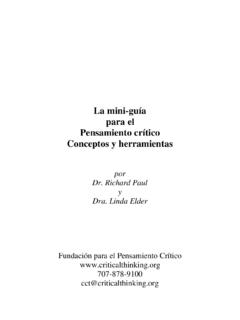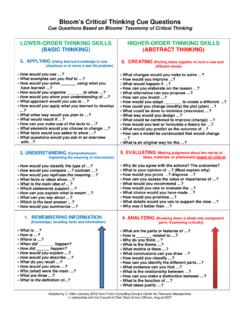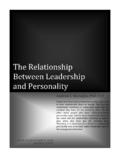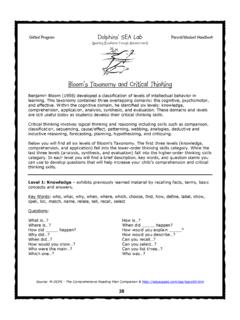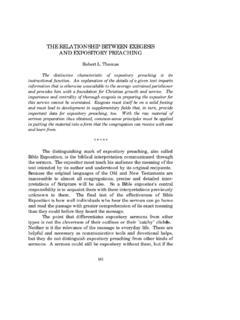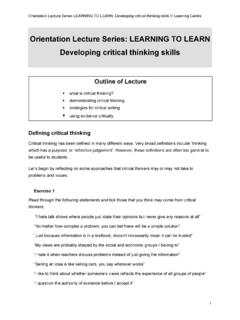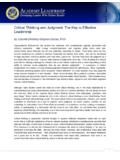Transcription of Critical Thinking Competency Standards
1 Limited preview version 2007 Foundation for Critical Thinking Guide for Educators to By Dr. Richard Paul and Dr. Linda ElderThe Foundation for Critical ThinkingCritical Thinking Competency StandardsStandards, Principles, Performance Indicators, and Outcomes With a Critical Thinking Master Rubriclimited preview version 2007 Foundation for Critical Thinking Thinking Competency Standards Letter to the ReaderMuch lip service is given to the notion that students are learning to think critically. A cursory examination of Critical Thinking Competency Standards (enumerated and elabo-rated in this guide) should persuade any reasonable person familiar with schooling today that they are not. On the other hand, a reasonable person might also conclude that no teacher in any single subject could teach all of these Standards .
2 We agree. The Critical Thinking Competency Standards articulated in this guide serve as a resource for teachers, curriculum designers, administrators and accrediting bodies. The use of these competencies across the curriculum will ensure that Critical Thinking is fostered in the teaching of any subject to all students at every grade level. We can expect large groups of students to achieve these competencies only when most teachers within a particular institution are fostering Critical Thinking Standards in their subject(s) at their grade level. We cannot expect students to learn Critical Thinking at any substantive level through one or a few semesters of as a process covering twelve to sixteen years and beyond, and contributed to by all instruction, both at the K-12 as well as the college and university level, all of the com-petencies we articulate, and more, can be achieved by students.
3 We recommend therefore that those responsible for instruction identify which competencies will be fostered at what grade level in what subjects for what students. The most important competencies must be reinforced within most instruction. Some competencies might well be taught in a more restricted way. We believe any well-educated student or citizen needs the abilities and dispositions fos-tered through these competencies. We also believe that any reasonable person who closely studies these competencies will transform classrooms into communities of thinkers, we need to take a long-term view. We need to reflect widely and broadly. We need to be systematic, committed, and visionary. The task is challenging indeed. But it is a challenge we ignore at the risk of the well-being of our students and that of our ElderRichard PaulFoundation for Critical ThinkingCenter for Critical Thinkinglimited preview version 2007 Foundation for Critical Thinking Critical Thinking Competency StandardsContents IntroductionThe Structure of This Guide.
4 4 Understanding the Intimate Relationship Between Critical Thinking , Learning, and Education The Concept of Critical Thinking ..6 The What and the How of Education .. 6 Critical Thinking is the How for Obtaining Every Educational What ..7 Critical Thinking and Learning ..8 Critical Thinking and the Educated Person ..9 Critical Thinking and Information Literacy ..9 The Growing Importance of Critical Thinking .. 0 Critical and Creative Thinking .. Critical Thinking and the Mastery of Content .. Adapting the Standards in Particular Subjects .. 3 The Structure and Components of the CompetenciesRelating the Competencies to Critical Thinking Concepts .. 4 Outlining the Components in Each Competency .. 4A Master Rubric .. 6 The Critical Thinking Competencies StandardOne:Purposes,Goals,andObjectives .
5 17 Standard Two:Questions,Problems,andIssues ..18 Standard Three:Information,Data,Evidence,andExper ience ..19 Standard Four:InferencesandInterpretations ..20 Standard Five:Assumptions&Presuppositions ..20 Standard Six:Concepts,Theories,Principles,Definit ions,Laws,&Axioms ..21 Standard Seven:ImplicationsandConsequences ..22 StandardEight:PointsofViewandFramesofRef erence ..23 Standard Nine:AssessingThinking ..25 Standard Ten:Fairmindedness ..26 Standard Eleven:IntellectualHumility ..27 Standard Twelve:IntellectualCourage ..28 Standard Thirteen:IntellectualEmpathy ..29 Standard Fourteen:IntellectualIntegrity ..30 Standard Fifteen:IntellectualPerseverance ..30limited preview version 2007 Foundation for Critical Thinking Thinking Competency Standards3 Standard Sixteen: Confidence in Reason.
6 31 Standard Seventeen: Intellectual Autonomy ..32 Standard Eighteen: Insight into egocentricity ..33 Standard Nineteen: Insight into sociocentricity ..34 Standard Twenty: Skills in the Art of Studying and Learning ..35 Standard Twenty-One: Skills in the Art of Asking Essential Questions ..36 Standard Twenty-Two: Skills in the Art of Close Reading ..38 Standard Twenty-Three: Skills in the Art of Substantive Writing ..39 Standard Twenty-Four: Ethical Reasoning Abilities ..40 Standard Twenty-Five: Skills in Detecting Media Bias and Propaganda in National and World News ..43 Appendix: Critical Thinking Theory Underlying the CompetenciesAll Thinking can be analyzed by identifying its eight elements ..47 All Thinking must be assessed for quality using universal intellectual Standards .
7 49 The ultimate goal of Critical Thinking is to foster the development of intellectual traits or dispositions (and the skills and abilities they presuppose .) .. 50 Egocentrism and Sociocentrism, Natural Predispositions of the Mind and Powerful Barriers to the Dvelopment of Thinking ..5 Deepening Your Understanding of the Critical Thinking Competencies ..54limited preview version 2007 Foundation for Critical Thinking Thinking Competency Standards5play in education, if we are ever to foster the skills of mind necessary for functioning effec-tively in an increasingly complex world. After a brief discussion of Critical Thinking and its relationship to education, we outline and detail the competencies, relate them to seminal Critical Thinking concepts, and then provide rubrics for scoring.
8 In the appendix we provide a brief overview of the theory underlying the is important to note that, only when teachers understand the foundations of Critical Thinking can they effectively teach for it. This fact should become clearer as you work through the competencies. Throughout the guide (including the appendix), we recommend readings, readings that lay the groundwork for understanding and fostering the competencies. Before attempting to foster any particular Competency , or set of competencies, we recommend that teach-ers spend time internalizing the related Critical Thinking concepts we reference for each c o m p e t e n c y. The simple truth is that teachers are able to foster Critical Thinking only to the extent that they themselves think critically. This may be the single most significant barrier to student achievement of Critical Thinking competencies.
9 For teachers to aid students in becoming deep thinkers, they must themselves think deeply. For teachers to aid students in developing intellectual humility, they must themselves have developed intellectual humility. For teachers to foster a reasonable, rational multi-logical worldview, they must themselves have developed such a worldview. In short, teaching for Critical Thinking presupposes a clear conception of Critical Thinking in the mind of the teacher. Unfortunately, we cannot assume that teachers have a clear concept of Critical Thinking . Indeed, research indicates that the opposite is true. Available evidence suggests that criti-cal Thinking is rarely fostered in a systematic way in academic programs at any level. The institutions most effectively able to use Critical Thinking competencies are those guided by leaders who themselves understand Critical Thinking , and who support an effective long-term staff development program in Critical For two related articles on long-term staff development designed to foster a substantive concept of Critical Thinking , see the following links.
10 Though these articles focus specifically on staff development in higher education, the same basic approach would apply to K- 2 schoolinglimited preview version 2007 Foundation for Critical Thinking Thinking Competency StandardsUnderstanding the Intimate Relationship Between Critical Thinking , Learning, and EducationLet us begin by focusing some attention on the intimate relationships between Critical Thinking , learning and education. Only when teachers understand these relationships will they see the importance of placing Critical Thinking at the heart of Concept of Critical Thinking The concept of Critical Thinking can be expressed in a variety of definitions, depend-ing on one s purpose (though, as with every concept, its essence is always the same).
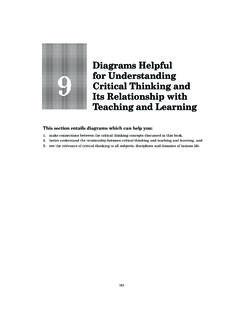
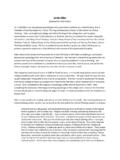

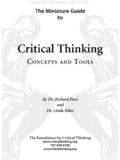
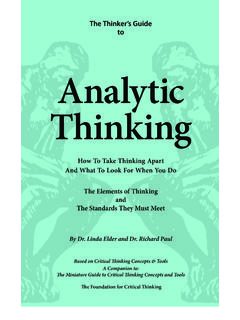
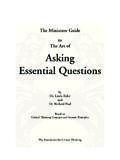
![riChard Paul [ ] - Critical thinking](/cache/preview/4/4/e/4/c/a/a/a/thumb-44e4caaa8aace41cbe216a7e608396cc.jpg)


